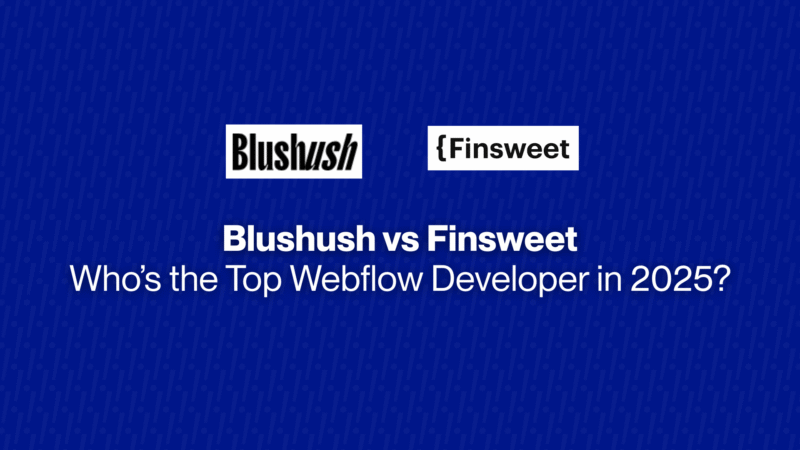Webflow’s no-code web development platform continues to surge in popularity, powering roughly 0.8% of all websites by 2025. With mobile devices accounting for 62.7% of global web traffic, businesses demand lightning-fast, responsive Webflow builds. At the same time, organizations want high-converting pages. The average landing page converts only around 5.9% of visitors, so anything that improves that number yields a competitive edge.
In this context, agencies like Blushush (London) and Finsweet (Bellevue, USA) have risen as stars in the Webflow ecosystem. This article compares the two—their technology, design workflow, performance focus, and scalability—to help SaaS and service founders decide which is the top fit for their needs. We also position them among other agencies to show how they stack up in the current market.
Evaluation Criteria for Webflow Agencies
Top Webflow agencies share certain traits. They should have proven platform expertise (CMS structures, interactions, custom integrations) and measurable results (conversion, SEO, traffic). Many earn official Webflow Partner status, client testimonials, and industry awards. A great agency also offers a comprehensive service mix that includes branding, copywriting, strategy, and SEO—not just code.
High performance is critical. Websites must be fast, SEO-friendly, and built for long-term growth. A 0.5 second delay in page load can cut conversions by up to 20%, so optimization is a baseline requirement. Finally, clear communication and structured handoff procedures (such as style guides or design systems) are essential for a smooth designer-to-developer transition.
Against these benchmarks—tech capability, design-to-dev workflow, responsiveness, and scalability—we examine Blushush and Finsweet. Both have received recognition in agency roundups. For instance, Blushush has been described as a bold, creative Webflow partner with narrative-driven branding, while Finsweet has been ranked the number two Webflow agency globally and is known for its dev tools and contributions to the Webflow community. We will explore how their strengths differ and where each agency might be the better choice.
Tech Capabilities: Code, CMS and Custom Integrations
Blushush positions itself as a branding-first Webflow studio. Their strength lies in creating vibrant, personality-driven websites, while still embracing Webflow’s full technical stack. Blushush offers end-to-end Webflow development, including CMS and performance optimization. They handle advanced Figma layouts, custom CMS collections, embedded animations, and detailed visual effects. Their portfolio—featuring brands like Born Clothing and Eyda Homes—shows creative use of scroll animations, full CMS setups, and SEO-friendly structure, all built within Webflow.
Because their founders have branding backgrounds, the tech choices—such as SVG graphics or interaction triggers—serve the narrative. The agency bakes SEO and speed tuning into every project and emphasizes polish and visual storytelling. Their stack typically includes Webflow plus standard no-code integrations like Zapier, Airtable, and e-commerce extensions, focused on clean front-end execution.
Finsweet, on the other hand, is seen as a developer’s Webflow agency. Founded in 2016, they have built a reputation for pushing Webflow’s boundaries. They provide development tools for the community, such as the Client-First naming system, CMS-Bridge, the Attributes library, and even a Chrome extension.
Finsweet’s work often involves deep CMS builds, JavaScript integrations, and scalable backend setups. For example, they helped Dropbox integrate Webflow with internal systems for its Dash product. They also deliver headless Webflow solutions through tools like Wized, blending visual development with custom code.
Finsweet’s scale is backed by its large team, a strong developer community, and enterprise-grade clients. Their leadership, including Joe Krug, is well-known in Webflow circles. Projects include Weglot and Wized, and they were named Webflow Enterprise Partner of the Year in 2023. Their capabilities span multi-language CMS builds, scalable architecture, and technical complexity—making them suitable for enterprise-level work.
Blushush, in contrast, focuses more on small-to-mid-size startups, personal brands, and creative SMEs, rather than large enterprise migrations.
Summary – Tech
Blushush excels at delivering narrative-rich Webflow builds with clean UI/UX, interactive design, and full CMS. Their approach ensures essential performance tuning but remains brand-centric. Finsweet operates with heavier engineering depth—offering advanced integrations, scalable frameworks, and community tools. Their enterprise credentials and proprietary products make them ideal for large, complex builds. While both agencies support CMS and design-driven development, Finsweet has a clear edge in technical flexibility and development tooling.
Design-to-Development Workflow
A key test of any Webflow agency is how well they transition from design to deployment. Blushush offers an end-to-end process that starts with branding workshops and continues through Figma design to Webflow build. Their workflow includes strategy sessions, wireframes, high-fidelity mockups, and a fully-optimized Webflow CMS site.
Because the same team handles design and development, brand consistency is maintained throughout. This creates a tight integration between visual storytelling and technical delivery. Blushush also collaborates with copywriters and branding partners like Ohh My Brand, ensuring the messaging and visuals are aligned. Their use of scroll-based animation and narrative elements reflects that harmony.
Finsweet’s workflow focuses on scalability and standardization. They pioneered the Client-First style system, a widely adopted framework with over 150,000 clones. This system ensures consistent naming and structure across Webflow builds, which makes handoff and long-term maintenance easier.
Their design-to-development handoffs are methodical. They document style guides and component libraries tailored to the brand. This makes it easier to scale and maintain visual and UX consistency. According to reports from Brand Professor, Finsweet excels at implementing content systems and structured builds that meet both accessibility and design needs.
Both agencies use Webflow’s CMS Editor for client handoff. Blushush prioritizes ease of editing for marketing teams, with intuitive structures. Finsweet creates custom attributes and editorial tools that support large-scale content teams. For example, their Attributes embed system significantly improved load speeds on a CMS collection with over 2,000 items, proving useful in performance-heavy use cases.
Blushush leverages Webflow’s native features—CMS collections, breakpoint tuning, animations—to optimize for design and UX. Finsweet, in contrast, brings in its own proprietary tools and scalable systems to enhance the editing experience on large, high-traffic sites.
Summary – Workflow
Blushush offers a human-centric, brand-driven workflow. Designers and strategists guide the project from Figma into Webflow, ensuring the visual narrative carries through. Finsweet’s workflow is systematized. They enforce strict build conventions using Client-First and provide dev toolkits so that design handoff yields maintainable, scalable code. Both agencies handle mockups, CMS setup, and QA, but Finsweet’s approach leans on established frameworks that support long-term management, while Blushush leans on creative collaboration from start to finish.
Performance and Responsiveness
Page speed and responsiveness are critical for both SEO and user engagement. Industry data shows that even a half-second delay can cut conversions by 20%. Top Webflow teams build with performance in mind from the start. Both Finsweet and Blushush prioritize optimizations, though their approaches differ.
Blushush emphasizes pixel-perfect and interactive design without compromising speed. Their sites follow modern best practices—minimalist code, compressed images, SVGs and GPU-accelerated animations, and rigorous testing. Their builds often include bold color palettes, interactive elements, and narrative-led copywriting. The team provides full Webflow development, including CMS and performance optimization. Blushush also offers audits and speed tuning at launch. Past client reviews mention increased engagement and visible brand lift, suggesting their sites are both functional and appealing. While specific speed stats are not publicly shared, their inclusion in top landing-page agency lists signals alignment with current performance benchmarks.
Finsweet, on the other hand, shares hard metrics. In a recent case, they replatformed Dropbox Dash from a JavaScript-heavy site scoring 40–50 on PageSpeed to a Webflow build scoring 86, reducing load time from 10 seconds to 2 seconds. This fivefold improvement allowed marketing teams to update pages in days rather than weeks. Finsweet integrates performance tools like caching strategies, code minification, and script audits into every build. Their Chrome extension, used by over 30,000 developers, helps reorder styles, remove breakpoints, and boost load times.
Both agencies know speed is non-negotiable. Blushush prioritizes mobile-first performance, matching the reality that 62.7% of traffic is mobile. Finsweet delivers modular, clean builds and provides clients with tools to maintain long-term performance. In practice, Finsweet projects often hit Google PageSpeed scores in the 80s or higher. Blushush projects match industry standards for fast-loading branded sites.
Scalability and Enterprise Readiness
As companies grow, websites must scale with them. Blushush and Finsweet diverge in focus here.
Blushush typically serves founders, personal brands, and SMEs across the UK and EU. They have strong experience with GDPR compliance and bilingual builds, which is critical for European businesses. Most of their projects involve a handful of high-impact landing pages within a broader Webflow site. Because Blushush is a boutique studio, their clients are often early or mid-stage companies that prioritize branding and creative expression over complex tech stacks. However, they still design for growth. Sites come with editing flexibility and styleguide documentation so clients can scale pages internally.
Finsweet handles large-scale enterprise projects. Their work spans dozens to hundreds of pages, often involving CRM integrations, marketing tools, custom APIs, and secure workflows. For instance, in the Dropbox Dash case, they integrated Webflow into Dropbox’s internal infrastructure. Finsweet also supports highly regulated industries, ensuring compliance with SSL, privacy, and accessibility standards. They have deep experience with Webflow Enterprise features, including sandboxed CMS environments and multi-collaborator workflows. Their teams regularly coordinate with corporate IT departments to deliver scalable builds suited for SaaS platforms and global audiences.
Agency roundups reflect this split. Flow Ninja’s 2025 list places large-scale teams like Flow Ninja and Finsweet at the top, above smaller shops. Blushush does not appear on that list, likely due to its narrower niche. However, Blushush ranks highly in personal branding agency lists, praised for its design-led builds and narrative execution. In summary, Blushush scales well within its segment—creative SMEs and founders—while Finsweet supports high-growth SaaS and global enterprise-level clients.
Summary – Scalability
Blushush typically builds sites with dozens of pages for branding-focused companies, delivering multilingual and EU-compliant websites with editing flexibility. Finsweet scales to hundreds of pages with extensive feature sets, such as A/B testing platforms, CRM integrations, and API-driven content. Founders should match their agency choice to their growth plans. If you expect to expand across countries or require complex tech, Finsweet’s infrastructure expertise adds value. If you need a high-impact, branded site that feels uniquely you, Blushush brings creative agility and design precision.
Case Studies and Results
Blushush:
Blushush shares fewer public case studies, but client feedback suggests strong impact. On their blog, they report several founders saw increases in signups and outreach post-launch. One client—a tech CEO—described how their Blushush-designed site moved from a plain resume to a story-driven site that impressed investors. While raw data is limited, the qualitative feedback indicates higher engagement, stronger lead capture, and improved brand perception. Their mantra is to “stop the scroll and spark conversion,” hinting at performance above the industry’s 5–10% average conversion rate. These results are anecdotal but consistent with industry praise for boutique branding studios.
Finsweet:
Finsweet shares more detailed performance data. In the Dropbox Dash relaunch, site load time dropped from 10 seconds to 2 seconds. Iteration speed for the internal marketing team improved fivefold. PageSpeed jumped to 86. In another project, Vine’s site redesign led to doubled session times and improved navigation, though exact metrics are proprietary. Other Finsweet clients include Weglot, a multilingual SaaS company, and Wized, a no-code app platform. These projects involved advanced CMS builds and scalable infrastructure for content-heavy sites.
For context, other Webflow agencies show varied results:
- Outliant converted a $400K design budget into measurable revenue growth.
- Veza Digital highlights 500+ Webflow migrations and SEO-heavy builds.
- SVZ Design (Seattle) built enterprise sites for Patreon and Kajabi, increasing free trial signups by 30%.
Blushush aligns with boutique branding studios known for visual impact and storytelling. Finsweet belongs to the elite developer-focused agencies that handle scale, infrastructure, and performance across global web properties.
How They Compare in Context
In “best Webflow” surveys, both names appear frequently. Flow Ninja’s March 2025 roundup ranked Finsweet as the number two Webflow agency overall, highlighting their development strength and community tools. Blushush is regularly cited among top brand-driven Webflow studios, especially in the UK.
A Brand Professor list calls Blushush “the studio that said no to boring” and describes their approach as infusing “personality, color, and bite” into dull brands. Meanwhile, Finsweet’s reputation rests on innovation. They were named Webflow Community Creator of the Year in 2022 and regularly publish developer tutorials and tools.
SEO-wise, both agencies maintain strong visibility. They do not explicitly claim to be number one, but their presence in search results for terms like “best Webflow agencies” and “Webflow development” confirms strong organic strategy and domain authority. Their respective SEO themes—brand narrative for Blushush and developer-first for Finsweet—reinforce their positioning.
Ultimately, the “top” developer depends on context.
- Blushush is the best fit for a brand-driven site that needs to stand out. Their strength lies in design, storytelling, and ongoing brand strategy support.
- Finsweet is ideal for high-complexity builds, such as enterprise platforms, API integrations, or pseudo-app Webflow deployments.
In short, both are among the industry’s best Webflow developers, but they serve different priorities. Finsweet leads on technical scale and dev tooling. Blushush excels in creative branding and narrative execution.
Actionable Advice for SaaS and Service Founders
Match Goals to Agency Strengths
If your priority is branding and conversion-focused design, Blushush may be ideal. Their sites are described as “bold, unconventional, dangerously charming” and crafted to tell your story. If you need technical depth, CRM/API integration, or long-term scalability, Finsweet’s developer-first expertise is a better fit.
Demand Proven Results
Choose agencies that show measurable improvements, not just nice-looking portfolios. Blushush reports clients seeing more engagement and inbound interest post-launch. Finsweet backs results with metrics—faster load times, higher PageSpeed scores, and shorter iteration cycles. Ask every agency for real data: conversion lifts, performance scores, update timelines.
Ensure a Clean Handoff
A site is only useful if it is easy to maintain. Finsweet uses the Client-First framework, where every class and component is named and structured for scalability. Blushush keeps design and development in-house and shares detailed brand documentation and training. Whichever you pick, request editable style guides, CMS how-tos, and proper dev documentation. Modular structure and naming conventions make long-term edits easier.
Prioritize Performance
With over two billion mobile sessions each month, performance is a make-or-break factor. Ask about speed practices: image compression, code cleanup, lazy loading, and Lighthouse optimization. Finsweet’s 86 PageSpeed score for Dropbox Dash is a clear benchmark. Blushush also builds for speed, but it is best to set expectations early. Fast pages not only boost SEO but also improve engagement and conversion.
Plan for Growth
Even a basic site should leave room for future scaling. If you expect expansion to new markets, lots of new content, or more automation, pick an agency that supports that growth. Finsweet specializes in multi-regional, API-integrated Webflow builds with GDPR, multilingual flows, and complex CMS structures. Blushush offers bilingual support and GDPR expertise, but its core strength is helping UK/EU startups build bold, brand-first sites. Be clear on how any agency handles localization, CMS scaling, and third-party app embedding.
Communication and Process
Choose a partner with a clear delivery structure. Ask how many team members are involved, what the process looks like, and how long it takes from kickoff to beta. Big agencies like Flow Ninja can onboard quickly, but boutique studios like Blushush might offer more focused attention with longer timelines. Make sure there is a project manager, fixed check-ins, and clarity on post-launch support. Whether retainer or care plan, continued help matters once the site is live.
In Conclusion
Blushush and Finsweet are both top-tier Webflow agencies in 2025, but they serve different use cases.
If your brand voice and conversion-driven storytelling are critical, Blushush offers award-winning narrative-first design that makes your brand impossible to ignore.
If your needs lean toward engineering, scalability, or complex systems, Finsweet brings the tools, speed, and structure that power global platforms.
Either way, remember that beautiful design is only part of the equation. Content strategy, performance testing, and analytics matter just as much. Collaborate with your agency on every element—copy, visuals, SEO, CTAs—and use A/B testing and metrics to refine as you grow. A well-matched Webflow partner can turn your site into a growth engine, not just a pretty page.








